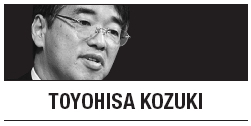TOKYO ― There was little surprise in President Barack Obama’s announcement late last year that the United States will strengthen its position in East Asia while drawing down its forces in Europe. After all, the security environment in East Asia is unpredictable and rapidly changing, unlike in Europe, where it is relatively stable. Against this background, efforts now underway to establish a comprehensive multilateral framework for the region can learn from the recent history of the Organization for Security and Cooperation in Europe (OSCE).

The U.S. is not alone in shifting its security focus to East Asia. Russian President Vladimir Putin’s decision to host Russia’s first Asia-Pacific Economic Cooperation (APEC) meeting in Vladivostok in September reflects his country’s growing interest in the region. And, like the U.S., Russia attended last November’s East Asia Summit (EAS).
The EAS, along with the ASEAN Regional Forum (ARF) ministerial meetings last July, made important contributions to improving the region’s security environment. The ARF’s effort to build a more predictable and constructive pattern of relations for the Asia-Pacific region is based on three stages: confidence-building, preventive diplomacy, and conflict resolution. At its 18th ministerial conference last year, ARF entered the second phase, preventive diplomacy, while continuing to strengthen confidence-building measures.
Maritime cooperation was a focus of attention at both the ARF ministerial meeting and at the EAS, not least because China’s activities in the South and East China Seas have generated fresh uncertainty in the region. The ARF welcomed the adoption of “Guidelines for Implementation of the Declaration on the Conduct of Parties in the South China Sea.” Likewise, the EAS focused on combating “sea piracy, search and rescue at sea, marine environment, maritime security, maritime connectivity, freedom of navigation, fisheries, and other areas of cooperation.”
Both meetings also focused on disaster management, with the ARF ministers reaching a common understanding on furthering regional cooperation. The ASEAN Coordinating Center for Humanitarian Assistance in Jakarta is expected to play a central role in building a disaster-related information network across the region, and in developing concrete measures for disaster management.
Similarly, many of the countries attending the EAS stressed the need for response capabilities, such as emergency disaster relief. Japanese Prime Minister Yoshihiko Noda announced his country’s readiness to host an international conference this summer on major disasters, giving Japan an opportunity to share lessons learned from the 2011 Great East Japan Earthquake and tsunami. The aim must be to make the region more resilient to natural disasters as part of a broader framework for regional cooperation.
The rapid changes occurring in the Asia-Pacific region demand policies to maximize growth opportunities while minimizing risks. That is why Koichiro Gemba, Japan’s foreign minister, has proposed new “open and multilayered networks” with other Asia-Pacific countries. “Multilayered” means multinational cooperation on various activities that can be promoted through bilateral, trilateral, or multilateral mechanisms. Work within the ARF and EAS frameworks is already aligned with this concept, and Japan is pursuing its own trilateral dialogues with China and the Republic of Korea, as well as with the U.S. and Australia.
Japan believes that these networks must be open to all of the Asia-Pacific region’s countries, as their establishment requires China’s full participation. But the rule needed to form the foundation of such a network must obviously adhere to international law, and the ARF meeting’s final declaration clearly reflected this concern.
This is where lessons from the OSCE’s experience are relevant to Asia’s budding efforts to establish a regional architecture. In particular, despite the significant socioeconomic and political differences between the Asia-Pacific region and Europe, the OSCE’s confidence- and security-building measures are worthy of careful consideration.
Such measures aim to reduce the risk of conflict by increasing trust among participating OSCE states, and by contributing to greater transparency in the field of military planning and other activities. The Vienna Document, which is the key to understanding these OSCE efforts, obliges annual exchanges of information on existing military forces, the structure of armed forces, and major weapons and defense systems. It also requires annual information exchanges on defense planning and budgets.
Adoption of such measures in the Asia-Pacific region would do much to promote confidence and trust among Asian countries. A few steps in this direction have already been taken within the ARF framework, including the publication for more than a decade of an Annual Security Outlook based on contributions from ARF countries. In 2010, ARF ministers widened the Outlook’s scope with the Simplified Standardized Format, which includes publication of national defense doctrines, defense expenditure, and the total number of personnel in a country’s armed forces.
There have been two main approaches to meeting modern regional-security challenges: traditional alliances of the NATO type, which prepare for any potential threat to members, and comprehensive multilateral frameworks of the OSCE type, which include all relevant players within a region.
As Europe’s post-1945 history clearly shows, traditional alliances and a comprehensive multilateral framework can be complementary, and are essential to maintaining regional peace and stability. Now the Asia-Pacific region is witnessing efforts to establish a similar comprehensive and multilateral framework through the ARF and the EAS. But, however successful such efforts may be, they will enhance, not lessen, the importance of existing bilateral relationships, such as the Japan-U.S. alliance.
By Toyohisa Kozuki
Toyohisa Kozuki is deputy director-general of the European Affairs Bureau of Japan’s Foreign Affairs Ministry. The views expressed here are his own, and do not reflect the official policy of the Ministry of Foreign Affairs of Japan or any other Japanese government agencies. ― Ed.
(Project Syndicate/Europe’s World)








